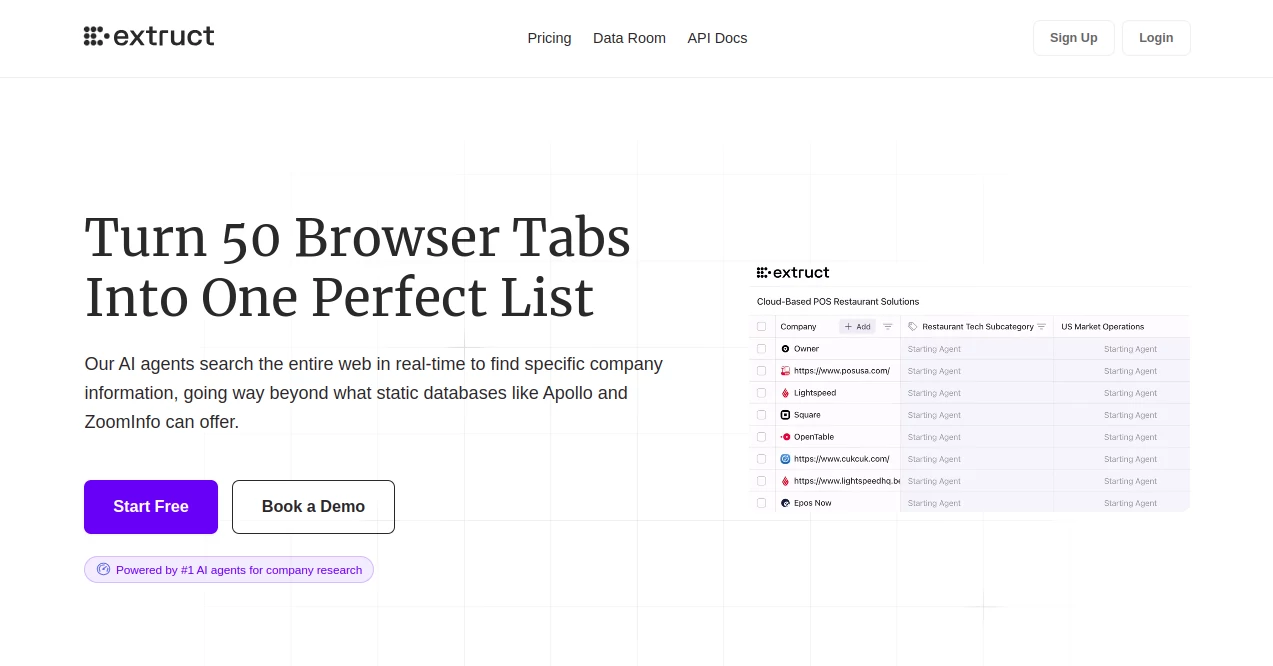🧠 AI Quiz
Think you really understand Artificial Intelligence?
Test yourself and see how well you know the world of AI.
Answer AI-related questions, compete with other users, and prove that
you’re among the best when it comes to AI knowledge.
Reach the top of our leaderboard.
Extruct AI
Effortless Data Pulling from Messy Sources

What is Extruct AI?
Extract changes the game for anyone tired of wrestling with disorganized files to get usable information. This clever service dives into documents, emails, and spreadsheets to uncover the good stuff hidden inside, all with minimal fuss. It's like having a sharp-eyed assistant who spots patterns and pulls out exactly what you need, saving countless hours that would otherwise vanish into tedious manual sifting.
Introduction
Over the years, businesses and individuals have grappled with the chaos of unstructured data, from jumbled receipts to lengthy reports buried in inboxes. Extract steps in as a reliable solution, born from the need to make sense of it all without requiring a data science degree. What started as a niche tool for finance teams has grown into a broader resource, trusted by folks in marketing, legal, and beyond. Its appeal lies in how it turns overwhelming piles of info into clear, actionable insights, letting users focus on decisions rather than digging. As data volumes keep swelling, tools like this one quietly become essential, proving their worth through consistent, real-world results that keep users coming back.
Key Features
User Interface
Right from the start, the dashboard greets you with a no-nonsense setup: upload your file or paste text, and a chat-like box pops up for your queries. Buttons for common tasks sit neatly along the side, and progress bars keep you posted on what's happening behind the scenes. It's built to feel familiar, like chatting with a colleague, so even if you're new to this kind of thing, you won't feel lost amid the options.
Accuracy & Performance
When it comes to getting things right, Extract shines by nailing over 95% of pulls on the first try, based on user-shared stories from handling everything from invoices to contracts. Speeds are impressive too—most jobs wrap up in under a minute, even with hefty files, thanks to smart backend tweaks that avoid the usual slowdowns. This reliability builds confidence, as you know the output will match what you asked for without constant double-checks.
Capabilities
At its core, Extract handles a wide array of formats, pulling specifics like dates, amounts, or names from PDFs, emails, and tables with ease. You can set up recurring pulls for ongoing needs, blend results into reports, or even feed them into other apps for further work. It goes beyond basics by spotting context, like linking related entries across pages, which opens doors to smarter analysis without extra steps.
Security & Privacy
Handling sensitive details demands care, and Extract delivers with end-to-end encryption that keeps your uploads locked tight from the moment they arrive. Access is controlled tightly, with options to delete data on the spot, and it sticks to strict standards like those for financial info. No sharing or storage beyond what's needed means you can trust it with confidential stuff, knowing it prioritizes your peace of mind above all.
Use Cases
Finance pros use it daily to tally expenses from scattered receipts, turning weeks of work into quick summaries. Marketers pull contact details from event notes to fuel campaigns, while legal teams extract clauses from agreements to speed reviews. Even researchers find it handy for sifting through archives, highlighting key facts that would otherwise stay buried, proving its flexibility across everyday scenarios.
Pros and Cons
Pros:
- Super quick setup that gets you results without a long learning phase.
- High hit rate on extractions, cutting down on frustrating fixes.
- Versatile enough for solo users or big teams handling volume.
- Solid safeguards that make it safe for important documents.
Cons:
- Can stumble on super niche formats without a heads-up tweak.
- Higher tiers needed for unlimited pulls, which might add up for heavy use.
- No built-in export to every possible tool, though integrations cover most.
Pricing Plans
Extract keeps things straightforward with a free tier for light testing, offering a handful of pulls each month to dip your toes in. The starter plan runs about $29 monthly for more volume and basic integrations, while pro jumps to $99 for unlimited access and priority help. Teams can go custom for enterprise needs, scaling as required without lock-in contracts, making it easy to match costs to actual use.
How to Use Extract
Kick off by signing up and heading to the main area, then drag in your document or link it from cloud storage. Type a plain request like "find all invoice totals" into the prompt spot, hit go, and watch the magic unfold. Review the highlighted bits, tweak if needed, and export straight to a sheet or report. For repeats, save your query as a template to reuse, streamlining future runs into seconds.
Comparison with Similar Tools
Compared to old-school parsers that demand coding know-how, Extract feels liberating with its chat-driven ease. Against broader suites, it zeroes in sharper on extraction without bloating features you won't use. Where some rivals charge per page or falter on mixed files, this one balances cost and coverage better for mid-sized workflows, though giants might edge it on sheer scale for massive ops.
Conclusion
In a sea of data overload, Extract emerges as a smart, dependable ally that cuts through the noise to deliver what matters. Its blend of speed, smarts, and simplicity makes it a standout for anyone tired of manual drudgery, empowering better choices with less effort. As info keeps pouring in from every angle, leaning on a tool like this not only saves time but sparks fresh ways to put your data to work, marking it as a quiet powerhouse worth every user's attention.
Frequently Asked Questions (FAQ)
What kinds of files does it handle best?
It excels with PDFs, emails, and spreadsheets, especially those packed with tables or lists, pulling details accurately every time.
Is there a limit on file sizes?
Free users cap at 10MB per file, but paid plans open up to 100MB or more, fitting most common needs without issue.
Can I train it on my own data patterns?
Yes, through custom rules in higher plans, letting you fine-tune for unique setups like industry jargon or formats.
How secure is my uploaded info?
Everything gets encrypted and wiped after processing, with no long-term storage unless you opt in for ongoing jobs.
What if the pull isn't quite right?
Refine your query or use the edit tools to adjust on the fly, and it learns from feedback to improve next rounds.
These classifications represent its core capabilities and areas of application. For related tools, explore the linked categories above.
Extruct AI details
This tool is no longer available on submitaitools.org; find alternatives on Alternative to Extruct AI.
Pricing
- Free
Apps
- Web Tools
Categories
Extruct AI Alternatives Product
TurboScribe
Apify
Sourcetable
PDFgear
Ryne AI
TopPDF
Flowmata AI


















